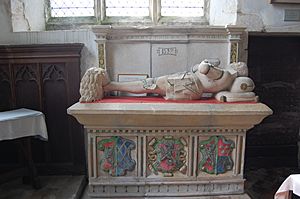Goddard Oxenbridge facts for kids
Sir Goddard Oxenbridge (died 1537) was an important English landowner and administrator from Sussex, England. He was also a Knight of the Bath, which was a special honor given by the King.
Contents
His Family and Home
Sir Goddard's family had lived in East Sussex for many generations. Their home was in a place called Brede. He made their family home, which was built in the 1300s, even bigger and better.
He was likely born in the 1470s. His father was Robert Oxenbridge, and his mother was Ann Livelode. Sir Goddard had a brother named John, who became a priest and a Canon of Windsor. His sister, Magdalen, was the mother of a famous courtier named Sir Nicholas Carew.
Sir Goddard's Public Life
Because Sir Goddard owned a lot of land, he was an important person in his community. This meant he also had public duties to perform for the King.
In 1506, he became the Sheriff of Surrey and Sussex for the first time. A sheriff was like a chief law enforcer and administrator for a county. He was chosen for this role again in 1512 and 1519.
On June 23, 1509, King Henry VIII was crowned. To celebrate, Sir Goddard was made a Knight of the Bath. This was a special award for knights who served the King.
He also helped keep the peace in his area in 1511 and 1512. In 1522, he was one of the knights who went to meet important visitors. These included Cardinal Wolsey, a powerful church leader, and Charles V, the Holy Roman Emperor.
Sir Goddard died on February 10, 1531. He was buried in Brede, and his tomb is still there today. You can see his statue in armor in St George's church.
His Land and Properties
When Sir Goddard died, his will showed he owned many properties. These included large estates and lands in various towns and villages. Some of these places were Beckley, Brede, Brightling, Burwash, Hastings, Rye, and Winchelsea. He even owned property in Southwark, which is now part of London. Many of these lands came to him through his first marriage.
His Family Life
Sir Goddard was married twice.
His first wife was Elizabeth. She was the daughter of Sir Thomas Etchingham. They had one child:
- Sir Thomas (died 1540), who also owned land in Etchingham. Sir Thomas married Elizabeth Puttenham. They had a daughter named Elizabeth, who later married Sir Robert Tyrwhitt.
His second wife was Anne (died 1531). Her father was Sir Thomas Fiennes. Sir Goddard and Anne had several children, including:
- Sir Robert (died 1574), who became a Member of Parliament (a person who helps make laws). He was also the Constable of the Tower, which meant he was in charge of the famous Tower of London.
- Elizabeth (died 1578), who was a lady at court and an author. She married Sir Robert Tyrwhitt.
The Legend of the Brede Giant
During Sir Goddard's lifetime, strange stories were told about him. These rumors were likely spread by smugglers who secretly used his estate as a hiding place.
The stories said that Sir Goddard was a giant of a man. People called him the "Brede Giant" or the "Sussex Ogre." It was rumored that he could not be harmed by metal weapons, and only wooden ones could hurt him.
The most shocking rumor was that he ate a child every night for supper! Several children had disappeared from the area, which made some people believe the gossip. Even though Sir Goddard was known to be a religious person, the smugglers and gossipers kept spreading these tales.
One version of the legend says that Sir Goddard was killed when he was not thinking clearly. Children, who believed the rumors, supposedly sawed him in half with a wooden saw at a place called Groaning Bridge. Some historians think these stories were spread by Protestants during the Reformation, a time of big religious changes, to make the Catholic Oxenbridge look bad.
Another idea is that the legend started much later, about 200 years after Sir Goddard died. In 1708, Brede Place was bought, and the house was left to fall apart. Smugglers then took over the empty house. They might have spread rumors that Sir Goddard's ghost haunted the place. They either made up the story about him eating children or added to an older tale to scare people away from their secret hideout.


